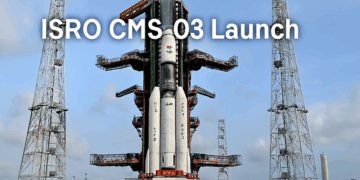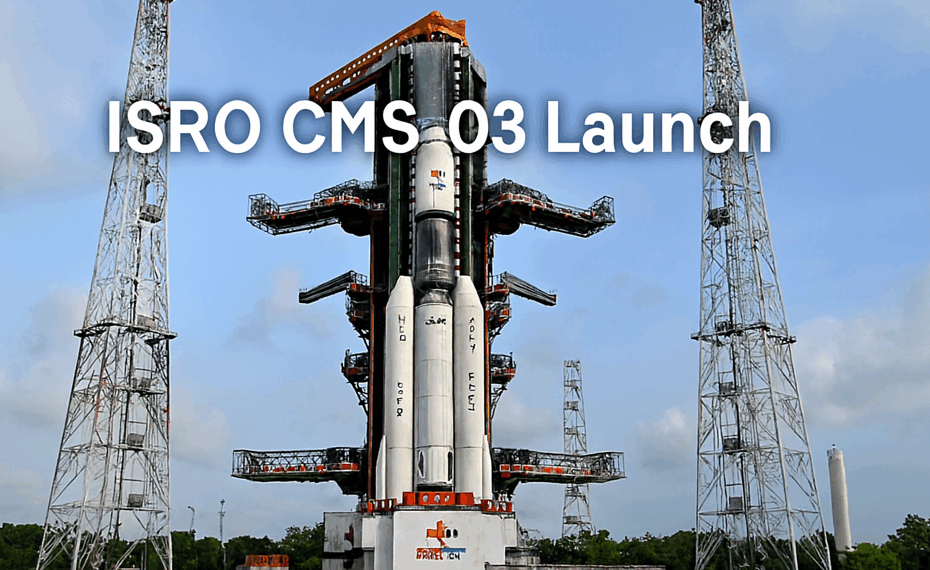Published: October 27, 2025 | Location: Sriharikota, India
Introduction: A New Chapter in India’s Space Journey
The Indian Space Research Organisation (ISRO) is once again at the forefront of technological advancement as it prepares to launch CMS-03, a next-generation communication satellite. Scheduled for liftoff on November 2, 2025, from the Satish Dhawan Space Centre in Sriharikota, the mission marks a strategic milestone in India’s quest to strengthen its digital and broadcasting infrastructure.
CMS-03 is the latest addition to ISRO’s fleet of communication satellites, designed to support high-throughput data transmission across the country. Riding aboard the trusted Launch Vehicle Mark-3 (LVM3), the satellite is expected to enhance services in telemedicine, education, disaster management, and rural connectivity.
Mission Objectives and Strategic Importance
At its core, the CMS-03 mission aims to bolster India’s communication backbone. The satellite will operate in the geostationary orbit, providing coverage across the Indian subcontinent. Its payload includes advanced transponders capable of supporting high-definition broadcasting, secure government communications, and broadband services in remote areas.
The timing of this launch is particularly significant. With India’s digital economy expanding rapidly and rural connectivity still lagging, CMS-03 is expected to bridge critical gaps. It will also serve as a backup and augmentation system for existing satellites like GSAT-30 and GSAT-19, ensuring continuity and resilience in national services.
Technical Specifications of CMS-03
- Satellite Type: Communication Satellite
- Orbit: Geostationary Orbit (GEO)
- Launch Vehicle: LVM3 (GSLV Mk III)
- Payload: Ku-band and C-band transponders
- Mission Duration: 12+ years
- Coverage Area: Pan-India and neighboring regions
The satellite weighs approximately 3,500 kilograms and is equipped with solar arrays capable of generating over 6 kW of power. Its onboard systems are designed for autonomous operation, with real-time telemetry and health monitoring.
LVM3: India’s Heavy-Lift Workhorse
The LVM3 rocket, formerly known as GSLV Mk III, has become ISRO’s go-to vehicle for heavy payloads. With a proven track record that includes the Chandrayaan-2 and OneWeb satellite launches, LVM3 offers reliability and scalability. Its cryogenic upper stage and dual solid boosters provide the thrust needed to place CMS-03 into its designated orbit.
Engineers at ISRO have fine-tuned the vehicle’s guidance and navigation systems to ensure precision deployment. The launch window has been carefully selected to optimize orbital insertion and minimize fuel consumption.
Behind the Scenes: Preparation and Testing
The CMS-03 satellite has undergone rigorous testing at ISRO’s Satellite Integration and Testing Establishment (SITE) in Bengaluru. Thermal vacuum tests, vibration simulations, and electromagnetic compatibility assessments were completed over the past six months.
Meanwhile, the launch pad at Sriharikota has been buzzing with activity. Technicians have completed vehicle integration, and final checks are underway. The countdown will begin 48 hours before launch, with real-time telemetry streamed to mission control centers in Bengaluru and Sriharikota.
Impact on Rural Connectivity and Broadcasting
One of the most anticipated outcomes of CMS-03 is its potential to transform rural connectivity. With over 600,000 villages still lacking reliable internet access, the satellite’s high-throughput capabilities could enable last-mile delivery of digital services.
Educational institutions, healthcare centers, and local governance bodies stand to benefit from improved bandwidth and secure communication channels. Additionally, broadcasters will gain access to expanded transponder capacity, allowing for more regional content and high-definition programming.
Global Relevance and Future Collaborations
The CMS-03 mission also positions India as a competitive player in the global satellite communication market. With increasing demand for satellite bandwidth from Southeast Asia and Africa, ISRO may explore leasing transponder capacity to international partners.
Moreover, the success of CMS-03 could pave the way for joint missions with space agencies like ESA, JAXA, and NASA. Collaborative efforts in satellite navigation, disaster response, and climate monitoring are already under discussion.
Voices from the Ground: Engineers and Citizens React
“CMS-03 is not just a satellite—it’s a promise of inclusion,” said Dr. R. Sivan, former ISRO Chairman, during a recent press briefing. “We’re building infrastructure that touches lives in the remotest corners of the country.”
Citizens in rural Andhra Pradesh expressed optimism. “If this satellite helps us get better internet and TV signals, it will change how we study and work,” said Suresh, a schoolteacher in Nellore.
Conclusion: A Launch That Resonates Beyond Technology
As the countdown begins for CMS-03, the excitement is palpable—not just among scientists, but across communities that stand to benefit. This launch is more than a technical feat; it’s a reflection of India’s commitment to inclusive growth, digital empowerment, and global leadership in space technology.
With CMS-03, ISRO continues to prove that space is not a distant frontier—it’s a tool for transformation, connection, and progress.
Source: ISRO Press Release, October 2025
Author: TradeAgroTechNews Editorial Team

















